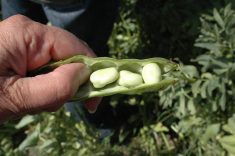Growing edible beans in Alberta has always been a bit of a gamble — more than one grower has paid off a land purchase with a good crop of the type of beans in demand that year. On the other hand, with any combination of a poor harvest, the wrong type of bean or a poor price, you could be in trouble unless you have crop insurance.
Recent years have dealt more than the average levels of poor luck for bean growers.
“Beans like hot, dry summers,” says Owen Clelland, manager of the Viterra Bean Plant in Taber. He says that despite working in the bean business for most of his career, even he was wondering how much more he wanted of it.
Read Also

New crop insurer policy enables easier startup for faba beans
Agriculture Financial Services Corporation updated its normals for faba beans, which may open the door for more Canadian producers to feel comfortable growing the pulse crop in the future.
“We really struggled for about three years, I think 2006 to ’09 when we had horrendous years with showery weather in late July and August. Then in ’09 and ’10 we had lousy harvest weather and we didn’t even harvest some beans, they were so poor. And we’ve had prices down around 20 cents a pound too.”
However, it wasn’t enough to cut bean acreage very much. Almost 46,000 acres of beans were contracted to Viterra this year. Clelland too is feeling better about the bean business again. Every type of bean has yielded well, but especially myocobas (yellows) and pintos, and they all came off in good condition. The Viterra plants at Taber and Bow Island are both full and so is an off-site facility that holds almost 10 million pounds.
Despite the big harvest, Clelland’s plant worked well for growers. Growers bring in beans right off the combine, because they undercut the plants a little below soil level so they catch all the pods and there’s quite a bit of soil along with the beans. When beans are delivered to the plant, they are scalped and the soil is returned to the farmer’s truck.
This year’s excellent harvest weather with no real break spread the deliveries more than usual. “Most trucks were in and out in an hour or an hour and a half,” he says. “When we’ve had a week of bad weather, everybody is rushing and waits are regularly four to six hours. This year the worst waits were two or maybe 2.5 hours.”
Good prices
Markets are good this year, too, especially for yellow beans. They sell into the southwestern U.S. and for the last few years they’ve sold for around 75 cents a pound, as long as the marketers can catch the period between our harvest and January, when Mexico’s brighter-coloured beans reach the market. Other types look set to make over 50 cents a pound.
“The yellows are the only type that we don’t have our own variety,” says Clelland. “The variety we have isn’t as bright as the Mexican varieties, but we have some nice ones coming along, probably in 2015 or 2016. We’ve a new Great Northern for next year. AC Tundra has all the good traits of our current variety, Resolute, with better yield potential.”
Clelland says good prices and high yields usually attract new growers, but he’s not ready to contract a lot of acres.
“That would be shooting ourselves in the foot,” he says. “We have to compete with U.S. and other growers and the U.S. has signed trade agreements with some of our traditional customers. We used to sell a lot of beans to the Dominican Republic and we had very good relations with some families. But now, our beans face import taxes 30 or 40 per cent higher than U.S. prices. Friendship only goes so far.”
The Canadian trade agreement with Colombia has allowed Alberta beans back into that country. But perhaps trade will never be quite what it was before the U.S. gained a trade advantage with its trade agreement. Viterra only contracts amounts of beans that match sale projections, although growers can grow any beans on spec and market their crop themselves. Clelland says most growers stay with beans year after year, sticking to their rotations.
“They’ll put in a little less if the markets look poor or a little extra when the market outlook is bright, but they’re long-term growers who realize you get ups and downs in any industry.”














